Link to corresponding reddit article here.
Yes you read the title right, I bought an NVIDIA TITAN V for BOINC.
Here’s what it looks like, courtesy of Anandtech (with older TITANs in the background):
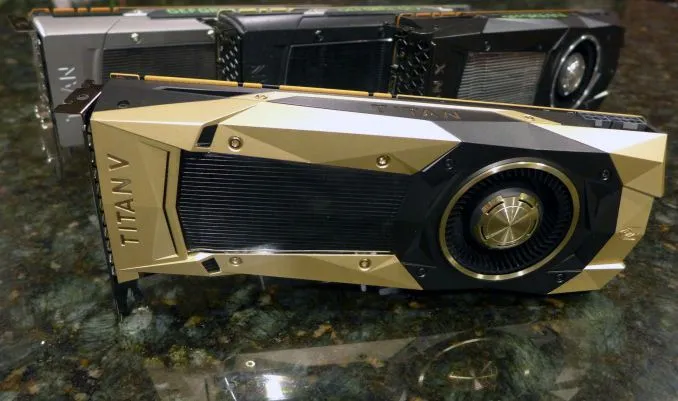
Is it awesome? Yes. Am I crazy? Probably.
So I guess the first question would be: “Why?”
Well, to answer that question I think we should take a look at the specifications for one of these bad boys compared to the 1080 Ti it’ll be up against later in the article.
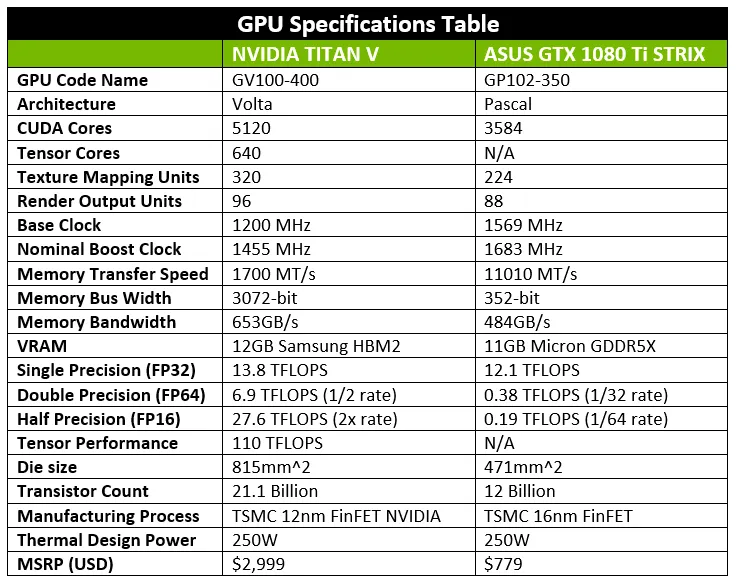
So the main reason I purchased the TITAN V for, was the ludicrous double precision compute power that’s displayed in this table. For reference, the R9 280X’s & HD 7970’s BOINC crunchers like to use for Milkyway only have roughly 1 TFLOP FP64! And obviously it’s no slouch at single precision either with its 5120 CUDA cores generating 13.8 TFLOPS. So despite the 250W TDP, the TITAN V actually has an interesting “maximum efficiency mode” that’s highlighted in the Tesla V100 datasheet.
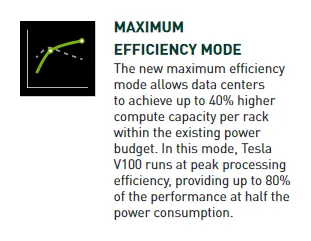
Now obviously this is partially a marketing gimmick, and although this material is for the Tesla V100, both the TITAN V and Tesla V100 use the same GV100-400 GPU, hence it’s still relevant. So, after having used and monitored the TITAN, seeing this maximum efficiency mode at work is incredible with the phenomenal amount of compute power you still get at the significantly lower power draw that will be showcased later in the article.
Testing Setup
So let’s get to the meatier part of this, how well does the TITAN V perform in BOINC tasks? I’ll be putting it up against my 1080Ti in these tests to use as a measuring stick to see how well it performs relative to something known.
Here’s the full specs for my rig that’s being used for this testing:
| Component | Description |
|---|---|
| CPU | Intel i7-4790K overclocked to 4.6GHz |
| CPU Cooler | NZXT Kraken X62 |
| Memory | 2 x 8GB G.Skill TridentX DDR3 @ 2400MHz |
| Motherboard | ASUS Sabertooth Z87 |
| Storage | Samsung 850 EVO 1TB, 1 x 3TB WD Green & Black |
| GPU 1 | NVIDIA TITAN V |
| GPU 2 | ASUS GeForce GTX 1080 Ti STRIX OC |
| PSU | Corsair HX1000i |
| Case | Coolermaster MasterCase 5 Pro |
And here’s a picture of it if you'd like to see what it looks like.
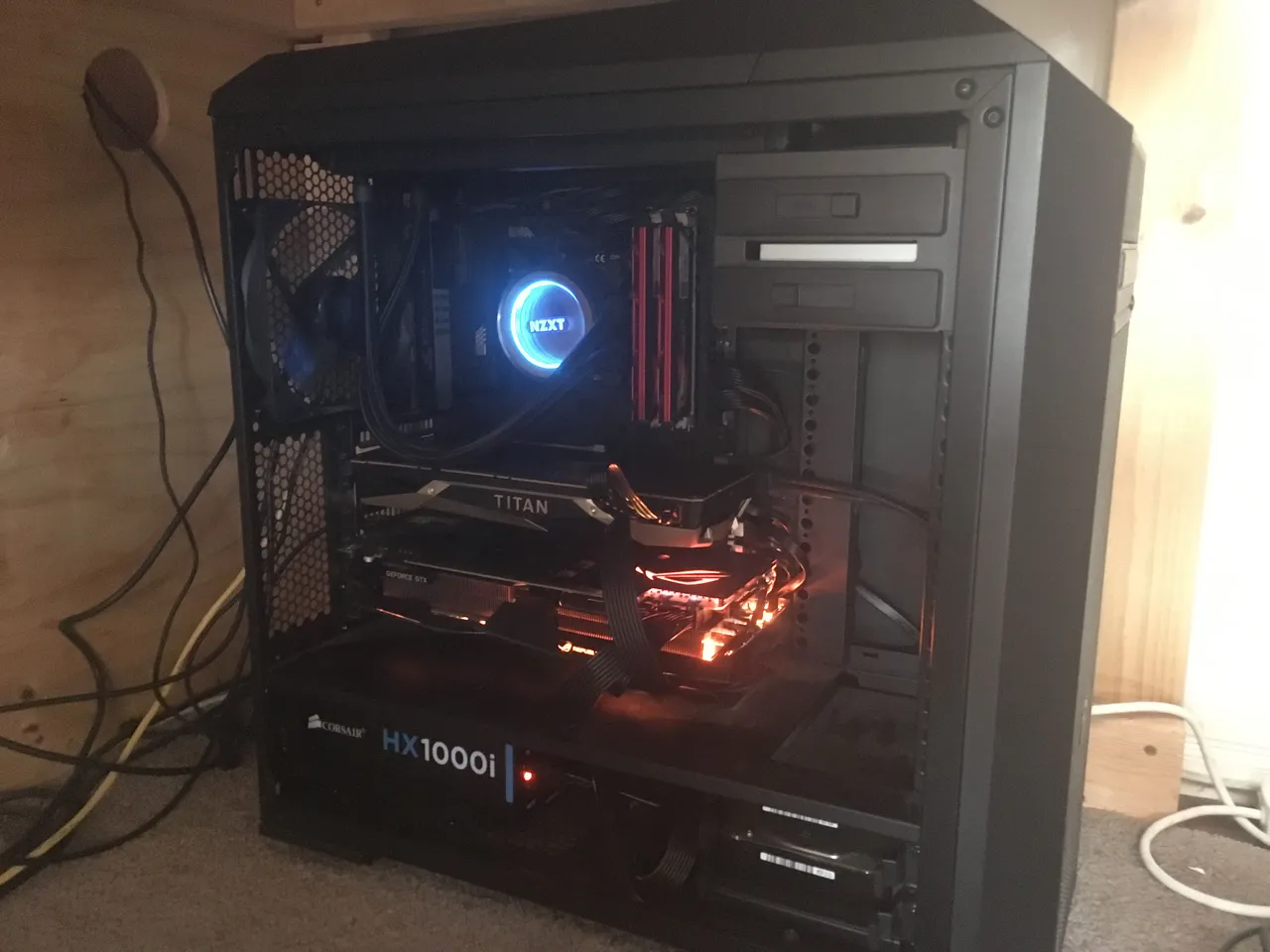
Testing was conducted at 29C ambient (damn Australian summer), and both GPUs were overclocked using the below settings in MSI Afterburner 4.40 using NVIDIA’s 390.77 driver.

Benchmarks
For this article I’ve tested Enigma, Primegrid (PPS-Sieve) and Collatz (Collatz Sieve) on both GPUs, and I’ve tested Milkyway on just the TITAN.
And for the results, I’m going to show an image of the BOINC Manager window which will show the completion time for the TITAN, and the relative progress of the task(s) running simultaneously on the 1080Ti, and also a screenshot of the HWiNFO64 monitoring program to show average power draw, temperatures and other statistics if you’re curious. In the BOINC screenshots, the upper task(s) are being run on the 1080Ti and the lower task(s) are being run on the TITAN. I’ll be using the average power draw in each screenshot to calculate magnitude per watt in the results table below this section. In addition, below each benchmark image I’ll provide some extra notes/analysis.
Primegrid

So Primegrid is probably the most intensive out of all the projects tested, and I’m using the app_config.xml file to run two work units in parallel for both GPUs. Immediately we can see the difference in efficiency between the TITAN and the 1080Ti, and also the pretty substantial performance difference. The TITAN completes the work units in just under half the time of the 1080Ti, and at just over half the power consumption.
Collatz

The story gets even worse for the 1080 Ti in Collatz, with the TITAN racing to finish at just over three minutes, while the 1080 Ti lagged behind significantly finishing at roughly 8 minutes and 30 seconds. It’s also worth noting that I did not perform any optimisations for Collatz, so these results are not indicative of optimised performance.
Milkyway
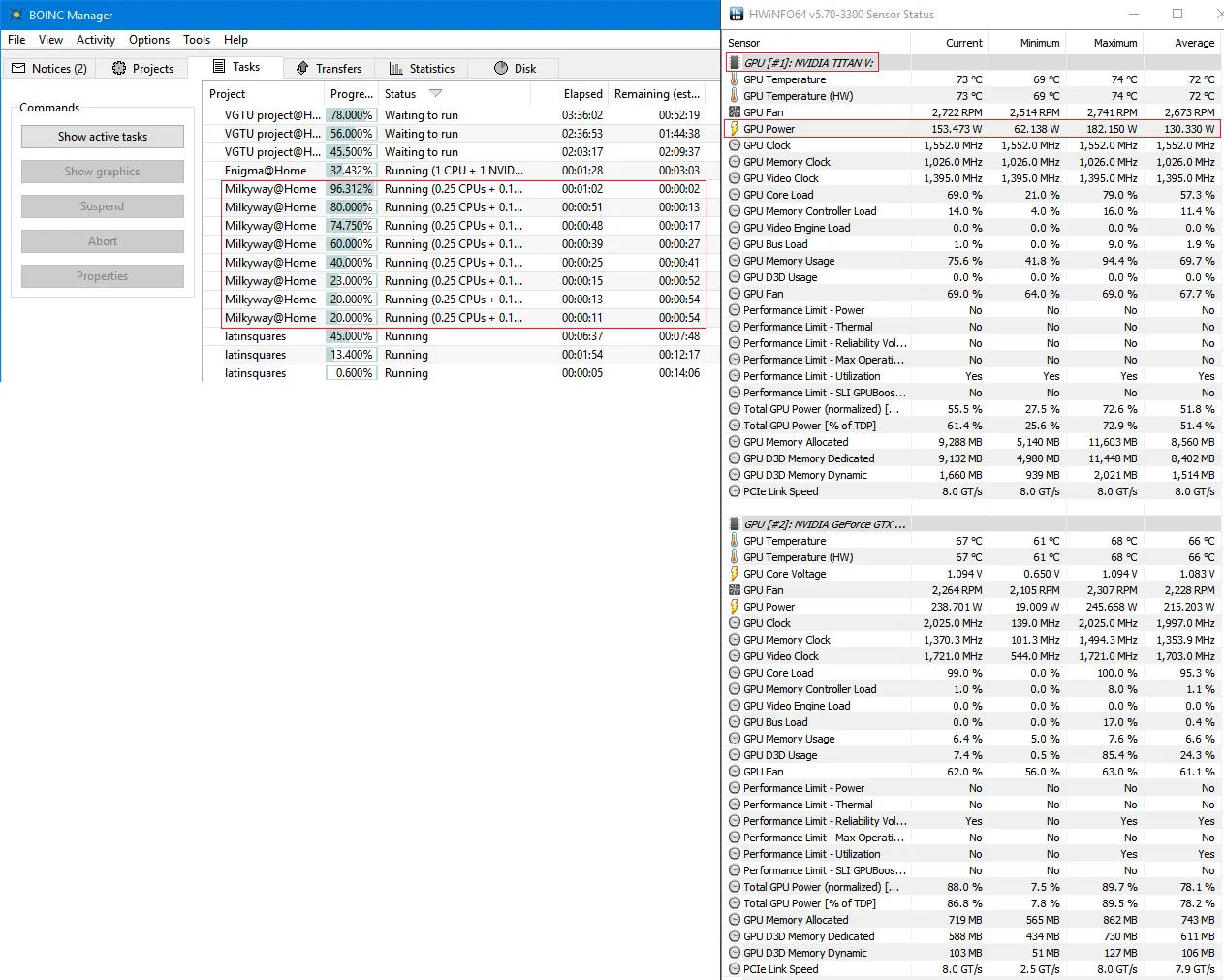
Milkyway’s work units don’t tend to finish in the same amount of time, so I’ll mention here that they roughly average out to 65 seconds per work unit. Here I’m running eight tasks in parallel, but I’ve staggered them. It’s pretty ridiculous how efficient the TITAN is at crunching these Milkyway tasks, only averaging 130W power draw for these eight tasks. There is also an important footnote regarding the TITAN and Milkyway I want to mention before the conclusion, so keep reading for that.
Enigma
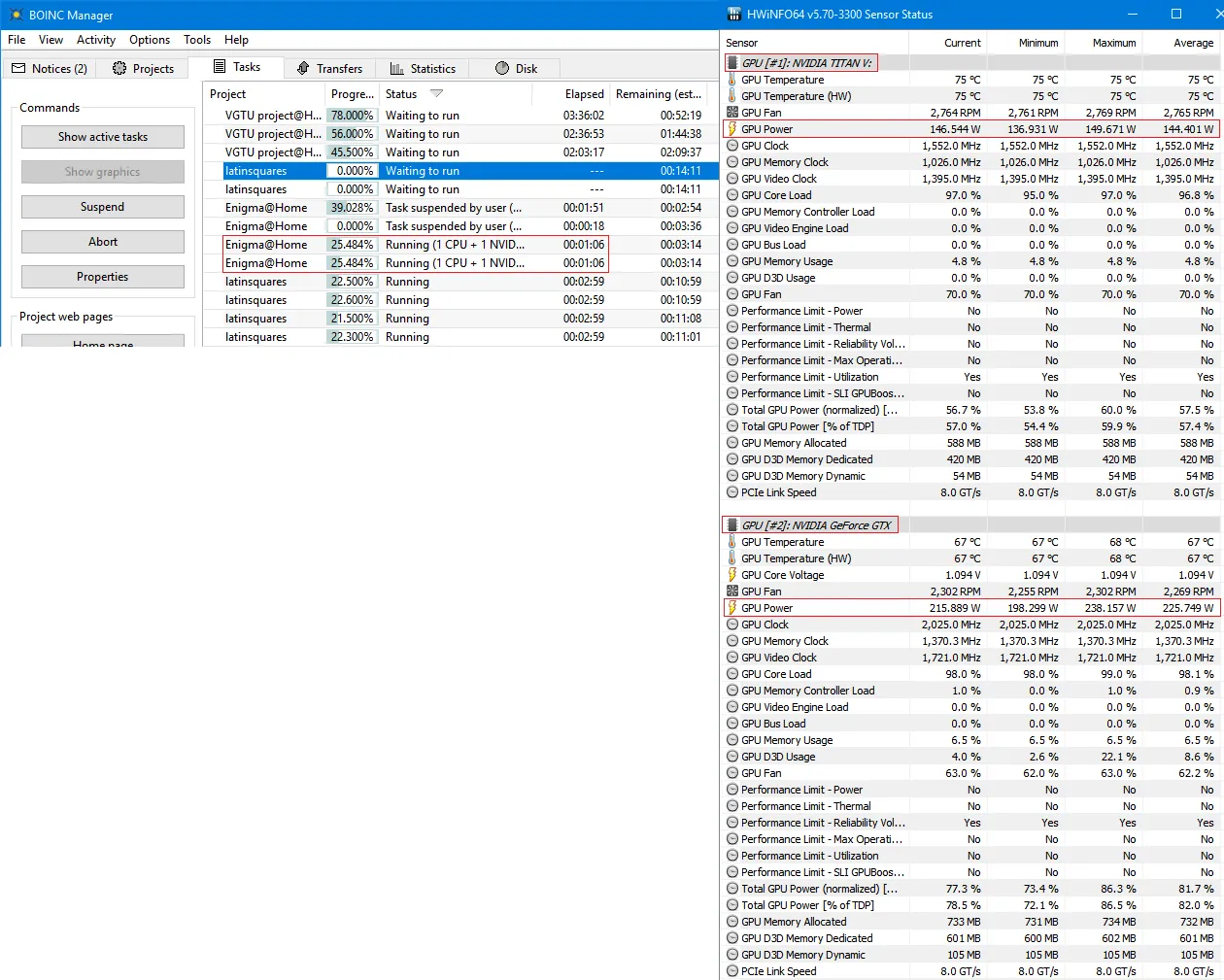
So since Engima uses a hill climbing algorithm, the time to completion cannot be accurately determined unless you average a large sample of results, so all I’m trying to show here is that the TITAN and 1080Ti are completely tied, and are being bottlenecked by something else. I imagine this would be the same for most of the other projects that aren’t as intensive as Collatz & Primegrid, so GPUGrid, Einstein, SETI etc. From my experience the Engima tasks usually take about 3 minutes and 30 seconds to complete on my 1080Ti.
Results
| TITAN V | Time to complete | Est. Max RAC | Est. Max Mag | Power Draw (W) | Mag/W |
|---|---|---|---|---|---|
| Primegrid | ~2:30 for 2 WUs | 3,883,392 | 162.98 | 190 | 0.858 |
| Collatz | ~3:00 for 1 WU | 18,075,144 | 175.68 | 183 | 0.960 |
| Milkyway | ~65s for 8 WUs | 2,416,541 | 177.54 | 130 | 1.365 |
| Enigma | ~3:30 for 1 WU | 1,814,400 | 56.81 | 144 | 0.394 |
| GTX 1080Ti | Time to complete | Est. Max RAC | Est. Max Mag | Power Draw (W) | Mag/W |
|---|---|---|---|---|---|
| Primegrid | ~5:00 for 2 WUs | 1,941,696 | 83.12 | 319 | 0.255 |
| Collatz | ~8:30 for 1 WU | 6,379,462 | 62.01 | 294 | 0.211 |
| Enigma | ~3:30 for 1 WU | 1,814,400 | 56.81 | 226 | 0.251 |
The estimated max RAC for each project was calculated as:

- n = number of WUs completed simultaneously
- c = credit per work unit
- t = time to completion for work unit(s) in seconds
The estimated max magnitude was calculated from multiplying mag/RAC by the above figure. Mag/RAC was calculated from analysing project statistics on gridcoinstats.eu’s website. These estimations are of course a rough approximation, and may not be entirely accurate.
A peculiar problem with the TITAN V for Milkyway
So before I get to the conclusion, there is an issue I’ve been having with the TITAN on Milkyway. The problem is, I can’t saturate all of the TITAN’s double precision compute using Milkyway tasks. So currently with 8 work units running simultaneously its GPU usage looks like this:
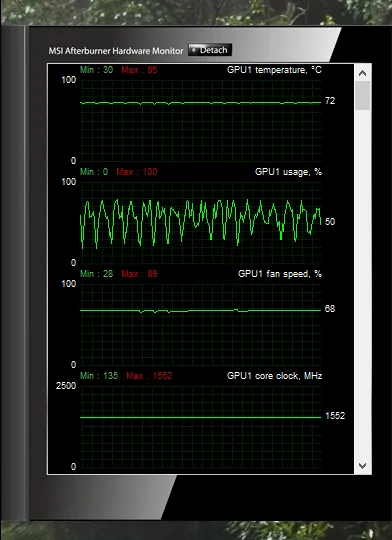
Obviously there’s still headroom for more work units right? We’re not at a consistent 100% usage. The problem is, each work unit uses approximately 1.5GB of VRAM, and if any work unit tries to allocate more than the 12GB of VRAM on the TITAN, all the work units error out. So effectively I’m capped at using 8 work units simultaneously unless I can somehow reduce the VRAM usage per task. At eight work units, this is what the GPU memory allocation graph looks like (Y-Axis is memory allocated from 0 to 12500 MB):
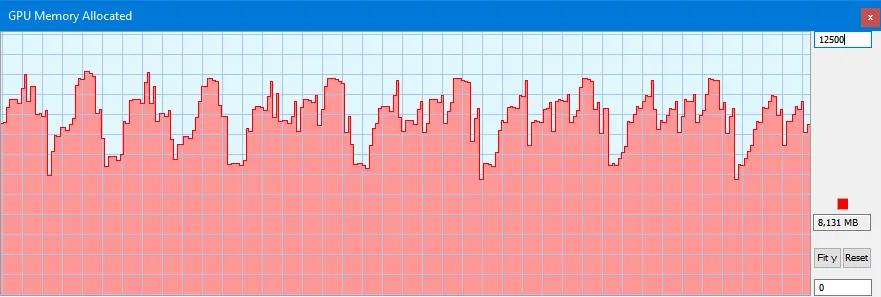
This is where you, dear reader, come in: if you know how to manipulate the app_config file or some other Milkyway setting to reduce VRAM usage, please let me know so I can push the TITAN to its full potential.
Conclusion
Despite the fact that the TITAN’s single precision compute is only theoretically 10 – 15% ahead of the 1080 Ti, it seems to perform significantly better than the 1080 Ti in heavier single precision applications, like Primegrid and Collatz. It’s also remarkably more efficient, providing three or more times more magnitude per watt than the 1080 Ti. The project I’m going to use for the TITAN is probably going to be Milkyway, with Primegrid as a backup since Milkyway has been having a lot of database and other server issues lately. So, if you guys want me to benchmark the TITAN on another project, feel free to ask in the comments below, or if you’ve got any other questions I’m happy to answer. Thanks for reading!